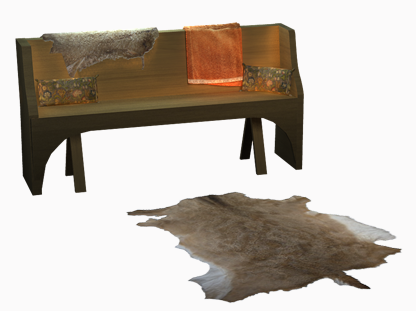Object Descriptions Tower House Parlor
Deerskins
Hunting was an aristocratic pursuit in Tudor England and Ireland, as well as an important source of meat and hides.
Many estates in Ireland had deer parks dating back to the later middle ages (from the Anglo-Norman invasion in the 1170s-80s on forward). Spenser did not have a deer park (that we know of) but his New English neighbors at Mallow Castle, Co. Cork, the Norris family, did. Legend has it that Queen Elizabeth I donated the first deer to populate the grounds at Mallow.
Spenser and/or his servants would also have had ample opportunity to hunt deer in the wild. The famously dense wood of Aherlow (“Arlo”) grew nearby to the north. They would have hunted red deer, a native Irish species.
In the castle recreation here, the deerskins are appropriately placed in an important domestic space, on a rocking chair and on the floor in front of the hearth. Deerskins are also placed in the Tower House Bedroom.

Literary Connections
We read about a deer hunt in Spenser’s neighborhood in the fragment of Book VII of The Faerie Queene, the “Two Cantos of Mutabilitie,” first published posthumously in 1609. In it, Spenser describes how the character Faunus, a wood-god, is punished by the virginal goddess of the moon and of the hunt, Cynthia (an allegorized Queen Elizabeth I), for spying on her while she takes a bath in the wood of Aherlow. The story loosely imitates that of Diana and Acteon in Book III of Ovid’s Metamorphoses: when Faunus is found out, he is punished by being draped with a deer skin and chased by Diana’s hounds:
But him (according as they had decreed)
With a Deeres-skin they couered, and then chast
With all their hounds that after him did speed;
But he more speedy, from them fled more fast
Then any Deere: so sore him dread aghast.
They after follow’d all with shrill out-cry,
Shouting as they the heauens would haue brast:
That all the woods and dales where he did flie,
Did ring againe, and loud reeccho to the skie. (FQ VII.vi.52)
The sound of Irish woods “echoing” a cry also features prominently in Spenser’s wedding poem, “Epithalamion” (1595). Whereas in “The Mutabilitie Cantos,” however, the shrieking or “shrill” cry of the enraged wood nymphs is deeply threatening to the male voyeur, in “Epithalamion” the ringing woods add a melodious, calming note to festivities that celebrate the marriage “ring”: an allusion to wedding bells and (obliquely) to the wedding band. The poem celebrates orphic harmonies in nature rather than orgiastic destruction. In this case, the woodsy nymphs invoked by Spenser guard the poet and his bride from harm at Kilcolman, as they prepare themselves for the ceremonies later that day. Spenser calls on the nymphs who are
… lightfoot mayds which keepe the deere,
That on the hoary mountayne vse to towre,
And the wylde wolues which seeke them to deuoure,
With your steele darts doo chace from comming neer,
Be also present heere,
To helpe to decke her and to help to sing,
That all the woods may answer and your eccho ring. (Epithalamion 67-73)
In this case his dear bride will be adorned by those who normally “keepe the deere” with “steele darts” or spears; one imagines that these darts are not are neglected entirely but are rather left (figuratively) at the church door for re-use once the ceremonies are done (Tower House Storage Room: darts).
Spenser compares his wife-to-be Elizabeth Boyle to a deer in Amoretti, the sonnet sequence written to court her and published with Epithalamion. In sonnet #67, he has finally achieved his love (his “deare”):
Lyke as a huntsman after weary chace,
Seeing the game from him escapt away,
sits downe to rest him in some shady place,
with panting hounds beguiled of their pray:
So after long pursuit and vaine assay,
when I all weary had the chace forsooke,
the gentle deare returnd the selfe-same way,
thinking to quench her thirst at the next brooke.
There she beholding me with mylder looke,
sought not to fly, but fearelesse still did bide:
till I in hand her yet halfe trembling tooke,
and with her owne goodwill hir fyrmely tyde.
Strange thing me seemd to see a beast so wyld,
so goodly wonne with her owne will beguyld.
The bride here becomes a Christ-figure as well. Spenser pursues a spiritual as well as a physical ideal. It is not a violent hunt that wins his bride but her own self-sacrifice and active desire to be won by the “beguiling” poet.
Bibliography:
Andrew Hadfield, Edmund Spenser’s Irish Experience: wilde fruit and salvage soyl (Oxford: Clarendon Press, 1997): 195.
Thomas Herron, “Native Irish property and propriety in the Faunus episode and Colin Clouts Come Home Againe.” Celebrating Mutabilitie. Ed. Jane Grogan (Manchester: Manchester UP, 2010), 136-77.
Richard D. Jordan, “Faunus, fauns.” The Spenser Encyclopedia. Ed. A. C. Hamilton (Toronto: U. of Toronto Press, 1990), 304-5.
Margaret Murphy and Kieran O’Conor, “Castles and Deer Parks in Anglo-Norman Ireland.” Eolas 1 (2006), 53-70.
Judith Owens, “Professing Ireland in the Woods of Spenser’s Mutabilitie.” Explorations in Renaissance Culture 29.1 (Spring 2003), 1-22.
Anne Prescott, “The Thirsty Deer and the Lord of Life: Some Contexts for Amoretti 67-70.” Spenser Studies 6 (1986), 33-76.